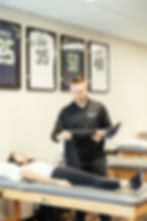Fix Your Hip Range Of Motion
- Dr. W Zach Smith
- Jan 16, 2023
- 4 min read
Updated: Jan 30, 2023
If you're an active adult, you're probably all too familiar with stiff hips. If you have ever felt limited squatting down, bending, or getting to the floor this is the feeling. We rely on our hips for a lot, so it's no wonder that they can sometimes become tight and uncomfortable. Luckily, over my years of being a physical therapists I have learned some great strategies to reduce the tightness and improve functional mobility.
Why The Hips Get Tight
Over time, your hips can become tight due to a number of factors. Tight hips can be caused by an imbalance in the muscles around the hip joint which leads to muscle tension and decreased range of motion. There are also certain lifestyle habits such as sitting for long periods of time that can contribute to tightness in the hips. In addition, weak core or lower back muscles may cause the hip flexors to work harder, leading to increased tightness in the hip area. Finally, any type of injury or trauma, such as falls or car accidents, may result in tightened hips.
Fortunately, there are several ways to reduce and prevent tightness in the hips. Stretching regularly is essential for keeping your hip muscles flexible and strong. Additionally, focusing on strengthening your core and lower back muscles can help alleviate tightness in the hip area. Regularly engaging in low-impact aerobic exercise is also beneficial for maintaining healthy hip joints. Finally, making lifestyle changes such as taking frequent breaks from sitting and avoiding activities that involve repetitive motions can help keep your hips loose and limber. By following these strategies, you will be able to enjoy more flexibility in your hips and reduce chronic tension and pain.
The importance of Dynamic Mobility for hip muscle tightness and limitation of hip range of motion
Dynamic mobility is probably the greatest area of benefit when we are talking about trying to improve range of motion of the hips. The different between dynamic mobility and the classic static type stretching is that you will be moving through out the stretch and will not be holding the stretch for long durations. The point is to get your joint and muscle to end range, and then to shorten or take it back to mid range. The thought behind this technique is that when moving, this is how the joints and muscles work. They are constantly moving and adapting to the change of position so it would make sense to train this. Here is an example of some dynamic mobility movements for the hips.
Strengthening To Reduce muscle Tension
I know this may sound extremely counterintuitive. Most people think that getting stronger makes you muscle bound or inflexible. I'm here to tell you that simply isn't true. In fact, strengthening your muscles can actually help to improve mobility. It may be hard to imagine, but it's true! When you strengthen the muscles that are needed for a certain movement (like squatting or shoulder flexion), they become more capable of performing that movement in an easier, fluid manner. For example, if you do regular squats, eventually those same movements will become much easier because your leg muscles have gotten stronger and better adapted at executing them. Additionally, when you strengthen the stabilizing muscles that surround a joint during a movement pattern, it helps to keep the joint stable which leads to improved control over said movement. This is especially important for people with arthritis or other joint issues. Below are a couple of our favorite movements for hip strength.
We also made a quick 5 minute mobility routine that you can go through. Check that out at our website here.
How Physical Therapy Can Help With hip tightness

Physical therapists are amazing musculoskeletal experts with great powers to reduce hip muscle tightness, limit physical strains and aches, and improve hip range of motion. Whether you’re dealing with hip pain, a sports injury, physical limitation or just seek physical improvement - sports physical therapy is the missing element in your quest towards physical health. It's important to understand that sports physical therapy can provide relief for greatly limited mobility and help patients gain greater flexibility and strength over time. Sports physical therapists often use soft tissue manipulation techniques such as massage, myofascial release, and joint mobilizations to help improve a patient's physical wellbeing. Regardless of your individual needs, physical therapy offers amazing ways to reduce muscle tightness while increasing movement in the hip area - allowing you to get back into living an active lifestyle!
Physical therapy is a great way to maintain a healthy lifestyle, providing relief from pain and discomfort, while rehabilitating muscle or other areas of the body. To enjoy success with physical therapy, start off by setting realistic expectations; it may take time and consistency to reach the desired end result. Have an open dialogue with your therapist so they can better understand what needs to be worked on, any particular limitations you may have, and how you’re feeling. Doing your exercises at home as prescribed is essential as well because this will give you longer lasting results that are apparent over time, not just during each session. Additionally, ensuring that you are relaxing in between sessions is key for prolonging positive outcomes because physical therapy should ultimately be about healing and creating balance in the body, not adding stress and straining your muscles further. When approached with this mindset there is no doubt success awaits!
Now that you know all about how to treat hip muscle tightness and limitation of hip range of motion with physical therapy, it’s time to find a qualified therapist. Check out our website or give us a call today to learn more about our services and how we can help you achieve your fitness goals.
